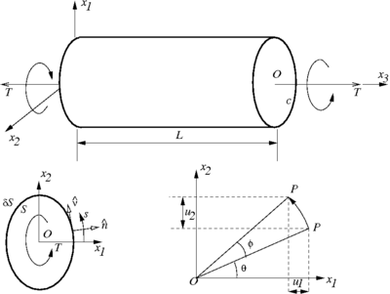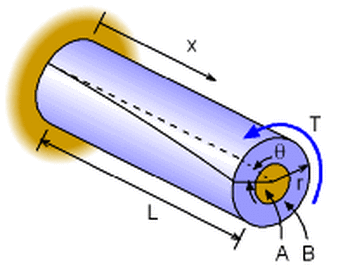Torsion & Shear Stress

Torsion is the twisting of an structure due to the applied torque.
Torsion acting on a long bar tends to twist it in the direction of the torque. The analysis is performed on a section perpendicular to the axis, and the sum of the internal resisting torque is set equal to the external torque acting on the system. The following assumptions will be made for the bars studied in this chapter :
1.Plane Sections Remain plane after the torque is applied .
2.The Shear Strain Varies Linearly In The Radial direction .
3.The material is elastic ,so Hook's law is applied .
Torsion Formula We want to find the maximum shear stress τmax which occurs in a circular shaft of radius c due to the application of a torque T. Using the assumptions above, we have, at any point r inside the shaft, the shear stress is τr = r/c τmax.
∫τrdA r = T
∫ r2/c τmax dA = T
τmax/c∫r2 dA = T
Now, we know,
J = ∫ r2 dA
is the polar moment of intertia of the cross sectional area..
Thus, the maximum shear stress
τmax = Tc/J
The above equation is called the torsion formula.
Now, for a solid circular shaft, we have,
J = πc4/2
Further, for any point at distance r from the center of the shaft, we have, the shear stress τ is given by
τ = Tr/J
We only consider the torsional loading of circular shafts in this analysis. Circular shafts are most commonly used as torque carrying members in machinery with rotating parts (like drive shafts of motors). This is fortuitous, as the analysis of non circular members under torsion is not simple to perform analytically.
Torsion acting on a long bar tends to twist it in the direction of the torque. The analysis is performed on a section perpendicular to the axis, and the sum of the internal resisting torque is set equal to the external torque acting on the system. The following assumptions will be made for the bars studied in this chapter :
1.Plane Sections Remain plane after the torque is applied .
2.The Shear Strain Varies Linearly In The Radial direction .
3.The material is elastic ,so Hook's law is applied .
Torsion Formula We want to find the maximum shear stress τmax which occurs in a circular shaft of radius c due to the application of a torque T. Using the assumptions above, we have, at any point r inside the shaft, the shear stress is τr = r/c τmax.
∫τrdA r = T
∫ r2/c τmax dA = T
τmax/c∫r2 dA = T
Now, we know,
J = ∫ r2 dA
is the polar moment of intertia of the cross sectional area..
Thus, the maximum shear stress
τmax = Tc/J
The above equation is called the torsion formula.
Now, for a solid circular shaft, we have,
J = πc4/2
Further, for any point at distance r from the center of the shaft, we have, the shear stress τ is given by
τ = Tr/J
We only consider the torsional loading of circular shafts in this analysis. Circular shafts are most commonly used as torque carrying members in machinery with rotating parts (like drive shafts of motors). This is fortuitous, as the analysis of non circular members under torsion is not simple to perform analytically.
Angle Of Twist

The above image shows the twist of a shafted acted upon by a torque T at one end. We know that the shear angle γ is given by
γ = τ/G
For a shaft of radius c, we have
φ c = γ L
where L is the length of the shaft. Now, τ is given by
τ = Tc/J
so that
φ = TL/GJ
γ = τ/G
For a shaft of radius c, we have
φ c = γ L
where L is the length of the shaft. Now, τ is given by
τ = Tc/J
so that
φ = TL/GJ
The angle of twist φ for a circular shaft acted upon by a torque Tx at a point x along its axis is given by:

where Jx is the moment at section x. Note that you can use the torsion formula for shafts with slowly varying area as long as they are circular.
